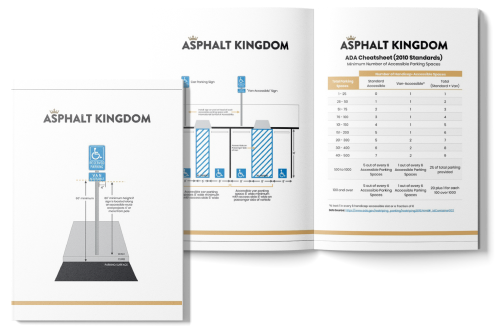Table of Contents
ADA parking space requirements ensure accessibility for individuals with disabilities, covering everything from space dimensions to placing proper signage.
Being ADA-compliant is not just about painting the international symbol of accessibility on pavement – although, it is a step in the right direction. The 2010 ADA Standards for Accessible Design is formulated as per the DOJ-sanctioned revisions of Titles II and III of the Americans with Disabilities Act of 1990.
This covers the scope regarding minimum requirements and provisions for handicap-accessibility in parking lots and similar facilities that are either newly designed, reconstructed or altered on or after March 15, 2012. Non-compliant facilities and installations can get fined or even face a civil lawsuit.
In this blog post, you’ll learn all about current ADA parking space requirements, including:
- The appropriate number of handicap-accessible spaces
- Handicap parking space requirements for signage
- Answers to commonly asked questions about ADA parking specifications
- And much more!
FREE DOWNLOAD!
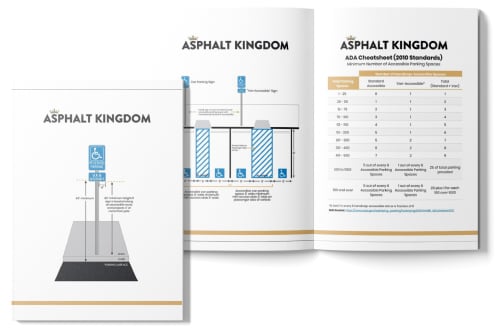
Get Your FREE Printable Cheat Sheet
To be fully compliant with the rules and regulations for handicap-accessible parking, the proper stall sizes, markings, and slot locations should be taken into consideration and observed.
If you are hired to apply new markings on a new parking facility, or to restripe an existing one, here are the points you need to know in order to guarantee compliance.
Number of Handicap-Accessible Stalls
A certain number of handicap-accessible stalls are required based on the number of available parking slots in a facility or site.
Per ADA parking space requirements, one in every six handicap-accessible spots should be designed for van-accessible parking. Should there be only one handicap-accessible space in a parking lot or garage with 25 stalls or less, that spot should be immediately customized for van accessibility. This ADA parking specification is applicable for public, employee, and restricted parking.
The table below shows how many corresponding handicap-accessible slots must be allotted in relation to the number of available parking stalls. However, the following exceptions should be noted:
- Medical facilities, such as hospitals, with outpatient services should have 10% more accessible parking spaces for patients/visitors.
- Rehabilitation centers or clinics that provide treatment or therapy for mobility-impaired or physical therapy patients should have an additional 20% more accessible parking spaces than the normal requirement.
- Parking lots that are exclusively used for buses, trucks, delivery vehicles, law enforcement vehicles, and vehicle impound lots are not required to include handicap-accessible spaces. However, while they may not have to adhere to certain handicap parking space requirements, if these facilities allow public access (such as when retrieving an impounded vehicle), they must have a handicap-accessible loading zone for passengers with disabilities.
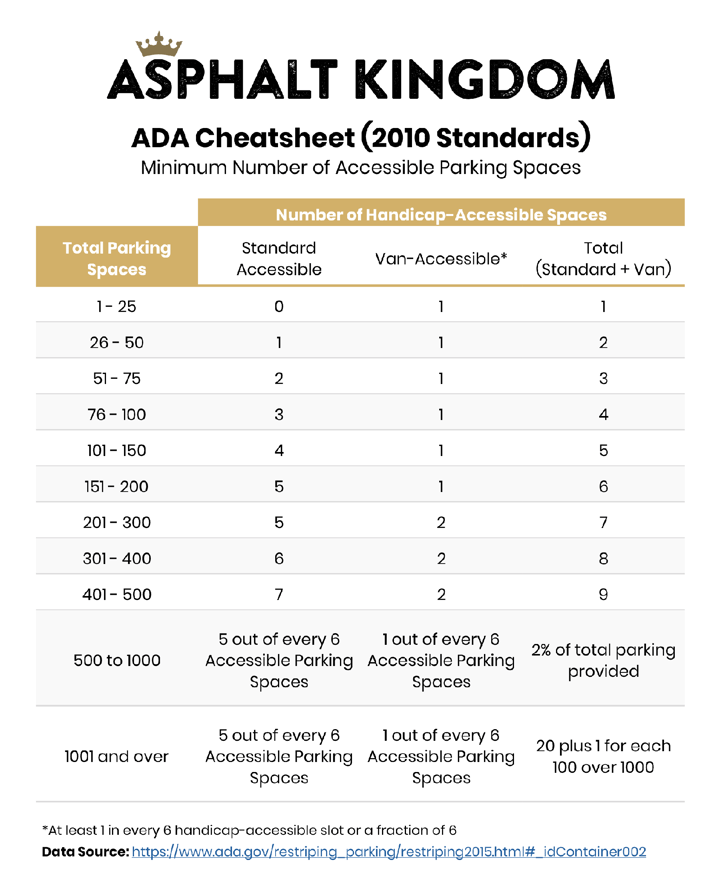
Right-click on the image above and choose "Save As" to share or print out
Sign up for our free Line Striping Course to learn more about line striping and discover how to do it yourself for your properties or add it to your existing business.
ADA Parking Space Requirements for Handicap-Accessible Signage
All accessible parking spots must be clearly marked with the International Symbol of Accessibility mounted on a pole. This symbol, usually rendered in white, depicts an individual in a wheelchair painted on a blue background.
ADA parking specifications list that these parking lot signs be at least 60 inches (5 feet) off the ground (from the parking surface) so they don't get blocked from view even if a vehicle is parked in front of it.
The post must be placed at the head of the parking space and should not obstruct the vehicles from pulling in and out of the stall. The sign must be visible from the driver's side of the vehicle. Van-accessible parking spots should have the corresponding text below the handicap-access symbol.
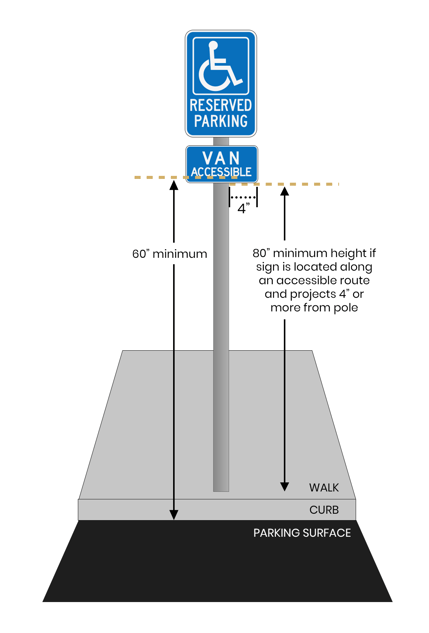
The Best Location for Accessible Parking Spaces
Handicap-accessible parking spots should be those closest to accessible entrances and exits, both for buildings serviced by the parking lot and the parking facility's own entrances and exits.
The purpose of this handicap parking space requirement is to ensure that handicapped drivers/passengers will have ease of access and right-of-way whether they need to enter or exit a parking lot, building or facility.
Assigning handicap-accessible parking slots closest to ramps that lead to entryways and entrance doors is also essential. Barriers that obstruct ease of access should be removed or relocated accordingly. If not, your business risks violating ADA parking space requirements.

Accessible Parking Space Size and Pavement Painting Specifications
According to ADA parking space requirements for standard accessible parking spaces, the minimum size should be at least 96 inches (8 feet) wide and should run the full length of the stall.
A 60-inch (5-foot) access aisle should be adjacent to the parking spot and should lead to an access ramp or accessible entryway.
The aisle is meant to provide room for individuals to easily deploy lifts, wheelchairs, walkers or any other mobility aids. One access aisle can be shared by two accessible parking spaces.
Van-accessible spots should be 132 inches (11 feet) wide and should also run the full length of the parking stall.
However, in some cases, the parking spot can be narrowed to 96 inches (8 feet) as long as the adjacent access aisle is also 96 inches (8 feet), rather than the customary 60 inches (5 feet).
ADA parking space requirements state that this access aisle should be on the passenger side of the van, as this is where lifts and wheelchairs are typically deployed.
Moreover, van-accessible parking spots, the adjacent access aisle, and the vehicular route should have a vertical clearance of at least 98 inches (8.17 feet) to accommodate the height of these lift-equipped vehicles.
When painting handicap accessible spaces, blue and white are the most common colors: blue for the background and white for the handicap-accessible symbol. You can use Asphalt Kingdom's Water-Borne or Oil-Based Traffic Paint for this.
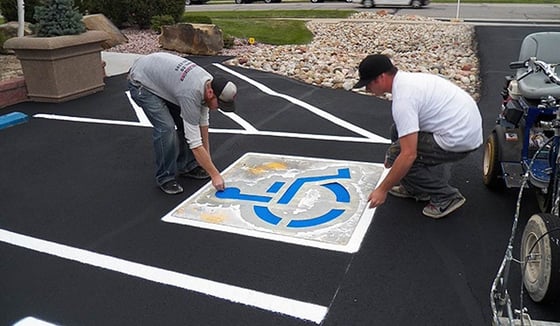 Painting the International Symbol of Access with blue and white traffic paint to adhere to ADA parking space requirements
Painting the International Symbol of Access with blue and white traffic paint to adhere to ADA parking space requirements
However, red, yellow and green may also be used. The ultimate goal here is to ensure that the pavement markings easily stand out from the color of the pavement surface.
Access aisles should be painted with diagonal hatch marks to discourage parking. Adding a “No Parking” pavement marking is also acceptable. Hatch marks are generally painted white.
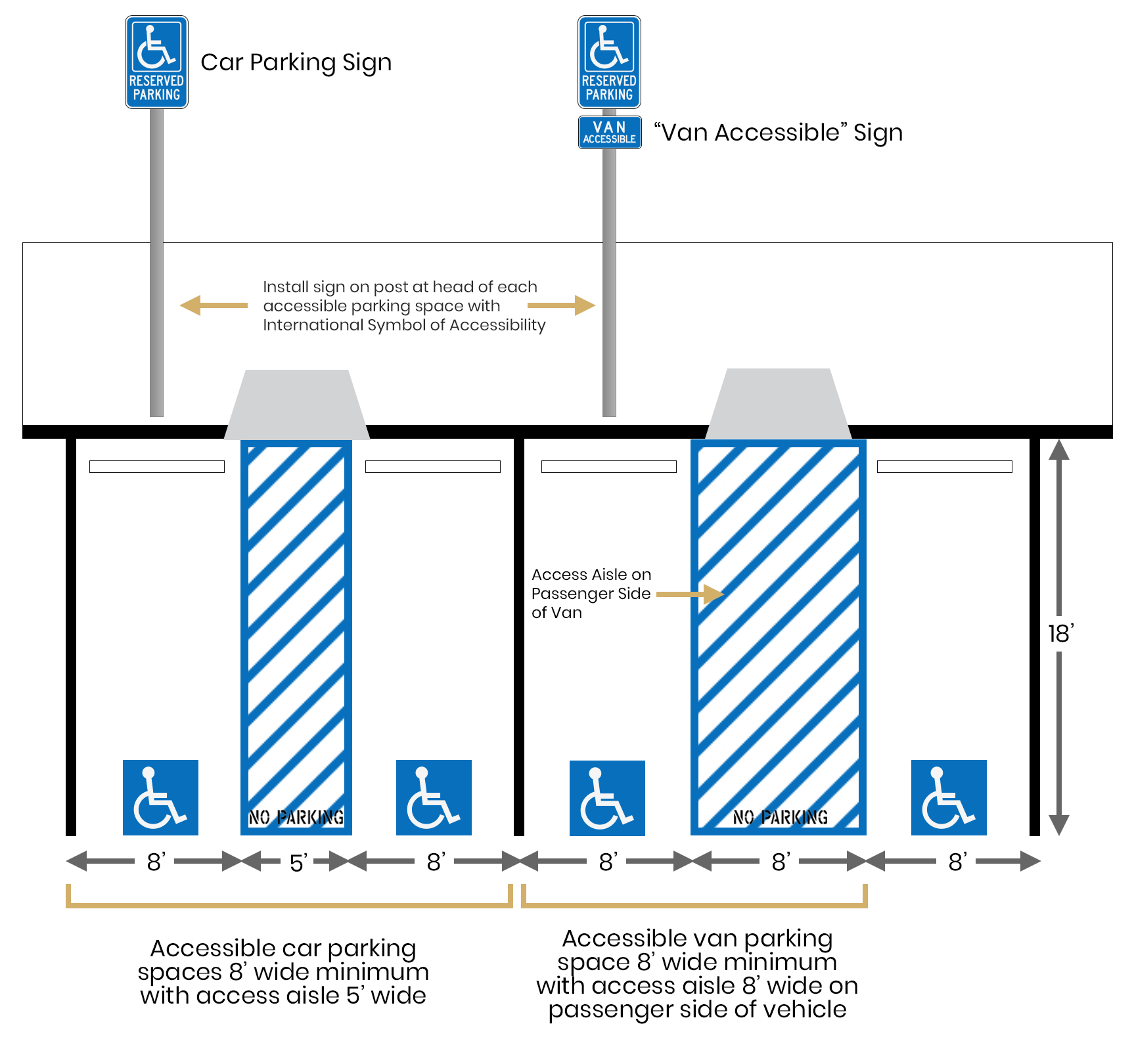
Not Sure How Much to Charge for ADA Handicap Painting?
This video tells you how much to charge for
- Handicap stenciling
- Hatch marks
- Parking lines
- Curbing
- Ramps
- and much more
Maintenance
Accessible parking spaces, their corresponding access aisles, through-ways and routes should always be kept clean and in good condition. Cracks and potholes should be repaired immediately.
Debris, fallen leaves, trash, loose pebbles, ice, mud and any other form of obstruction should be cleared off. Ensure that accessible spaces are always free from obstructions.
Learn everything you need to know on how to maintain your asphalt by taking our Pavement Asset Management Course for free.
The Titan PowrLiner 3500 is a powerful line striper for small to medium-size parking lots.
Governing Laws and Other Requirements
The above ADA parking specifications ensure that establishments and facilities provide accessible parking to individuals with disabilities. However, these are general rules and regulations.
Various states and local governments have their own handicap parking space requirements, which may be more specific and strict. It is best to check handicap-accessible requirements in your city or locality to ensure accuracy and proper observation before striping a parking facility.
Non-compliance with these requirements is punishable by law and can result in fines ranging from $1,500 to $10,000 or higher.
FAQs
What are the ADA parking requirements?
These regulations ensure accessibility for individuals with disabilities. They include specifications for:
- Parking space dimensions
- Signage
- Ramps
- Aisles
How many handicap spaces are required in a parking lot?
It depends on a lot’s total parking spaces. Generally, ADA parking space requirements state that 2% of spaces must be accessible, with at least one van-accessible space.
What are the dimensions and signage requirements for ADA-compliant handicap parking spaces?
According to ADA parking specifications, compliant spaces typically have a minimum width of 8 feet, proper signage with the International Symbol of Accessibility, and adjacent access aisles for wheelchair users.
Can non-compliance with ADA parking space requirements result in penalties or lawsuits?
Yes. Non-compliance can lead to penalties and lawsuits. Failing to meet these standards can result in fines, legal action, and reputational damage to businesses.
Are there any recent updates or changes to ADA parking specifications?
Yes. They change over time. It's essential to stay updated with the latest ADA guidelines to ensure compliance.
Where can I find a quick reference or cheat sheet for ADA parking space requirements?
You can find quick reference guides and cheat sheets on official ADA websites, local government resources, or through organizations specializing in accessibility compliance. These resources make it easier to understand and implement ADA requirements.
Whether you are a property owner, manager or contractor, it is best to be knowledgeable of the general rules and regulations when it comes to designating handicap-accessible parking spaces.
Not only will this benefit handicapped members of your community or locality, proper observation will also ensure that you don’t get sanctioned for non-compliance.
FREE DOWNLOAD!
